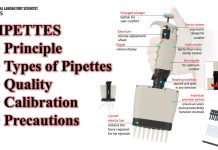BLEEDING TIME
Bleeding time is a medical test that measures the time it takes for a small puncture wound to stop bleeding. It is used to assess the overall functioning of platelets and the blood vessels. Platelets are small cell fragments in the blood that play a crucial role in blood clotting.
PRINCIPLE:
The cessation of bleeding in response to a standard incision on the volar surface of the forearm initiates the mechanisms that halt bleeding. The time taken for the blood to naturally stop flowing from the wound without any assistance defines the bleeding time. This duration is reliant on platelet number and function. A reduction in platelet count below a critical level or functional abnormalities can lead to a prolonged bleeding time. Disorders like von Willebrand disease, characterized by disturbed platelet function due to the absence of vWF, also extend bleeding time.
REQUIREMENTS:
- Sphygmomanometer
- Lancet or template
- Circular filter paper
- Stopwatch
METHOD:
Bleeding time measurement can be conducted using two methods:
1. Duke’s Method:
Primarily used in infants and children, this method involves making incisions in the ear lobe, finger pulp, or warm heel due to their rich capillary content.
- Clean the site with a spirit swab and let it dry.
- Deeply puncture the chosen site using a lancet to ensure free blood flow.
- Start the stopwatch and blot the drop of blood at intervals until bleeding stops completely, noting the time when no blood mark remains on the filter paper.
2. Ivy’s Method:
Considered the standard method, it involves these steps:
- Place the sphygmomanometer cuff on the patient’s arm while supine on a couch, maintaining a cuff pressure of 40 mm Hg throughout the test.
- Clean the forearm’s volar surface and select an area without visible veins.
- Make separate punctures, 4-8 mm long and 1 mm deep, along the forearm’s long axis, allowing free blood flow.
- Start the stopwatch and blot the oozing blood at 15-second intervals until bleeding ceases entirely.
PRECAUTIONS:
- Verify the platelet count before the test; if it’s below 50×109/L, avoid conducting the test.
- Ensure incisions are 1 mm deep to prevent wound closure and maintain standard blood pressure, incision number, and size.
- Select a vein-free skin area for puncture.
REFERENCE RANGE:
- Duke’s Method: 2 – 7 min
- Ivy’s Method (lancet): 2 – 7 min
- Ivy’s Method (template): 2.5 – 9.5 min
INTERPRETATION:
1. Prolonged Bleeding Time Occurs in:
-
-
- Thrombocytopenia
- von Willebrand disease
- Platelet function defects
- Aspirin ingestion
- Severe Factor V or XI deficiency
- Afibrinogenaemia
-
2. Shortened Bleeding Time:
-
-
- Commonly results from faulty technique rather than any specific condition.
-

















































